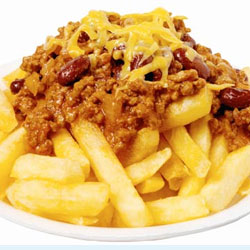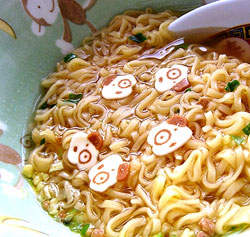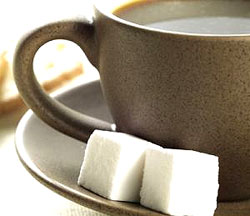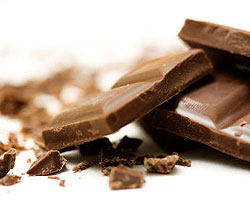|
|
Top 10 Foods worst to consume
We all need a little
fat and
sugar in our diets; however, too much
of both can lead to
unwanted weight gain and increases the risk of
heart disease,
high blood
pressure,
diabetes and other major
health problems.
If you're looking to slim down, there are
plenty of foods out there to halt your diet success. Some of the worst to
consume include:
  Cheese fries:
According to the book Eat This, Not That, an order of Aussie cheese fries
with Ranch dressing from Outback Steakhouse contains 2,900 calories and 182
grams of fat. This order is equivalent to eating 14 Krispy Kreme doughnuts
before your dinner arrives. Cheese and butter typically contain over ten
times as much
saturated fat as fish and white meat chicken and turkey. Add the
carcinogenic potential from heated and overcooked oils (usually
trans
containing) delivered in fries with the powerful
cancer inducing properties of
carbohydrates cooked at high heat (acrylamide formation) and you have a great
cancer potion. Cheese fries:
According to the book Eat This, Not That, an order of Aussie cheese fries
with Ranch dressing from Outback Steakhouse contains 2,900 calories and 182
grams of fat. This order is equivalent to eating 14 Krispy Kreme doughnuts
before your dinner arrives. Cheese and butter typically contain over ten
times as much
saturated fat as fish and white meat chicken and turkey. Add the
carcinogenic potential from heated and overcooked oils (usually
trans
containing) delivered in fries with the powerful
cancer inducing properties of
carbohydrates cooked at high heat (acrylamide formation) and you have a great
cancer potion.
 Fried desserts:
Fried desserts are another "worst" food. "You're dipping something in batter
that is already high in calorie, high in fat, high in sugar," Sarah Krieger,
M.P.H., R.D., a national spokesperson for the American Dietetic Association. Fried desserts:
Fried desserts are another "worst" food. "You're dipping something in batter
that is already high in calorie, high in fat, high in sugar," Sarah Krieger,
M.P.H., R.D., a national spokesperson for the American Dietetic Association.
 Soda:
When Purdue University researchers had people consume 450 calories a day from
either jelly beans or soft drinks for four weeks, the candy-eaters consumed no
more total calories than usual. The soda drinkers, however, downed 17-percent
more calories each day. Soda is loaded with artificial colors and sugar. Studies
have also linked soda consumption to
osteoporosis,
obesity, tooth decay and
heart disease. Sugary drinks such as squashes and carbonated fizzy drinks
(including sports drinks) can result in dental erosion and decay. Diet drinks
are not recommended either as they contribute to dental erosion as the bubbles
in the drink are acidic. Water and milk are the best drinks to consume between
meals. With just a medium popcorn and Coke, you�re at nearly 1,200 calories Soda:
When Purdue University researchers had people consume 450 calories a day from
either jelly beans or soft drinks for four weeks, the candy-eaters consumed no
more total calories than usual. The soda drinkers, however, downed 17-percent
more calories each day. Soda is loaded with artificial colors and sugar. Studies
have also linked soda consumption to
osteoporosis,
obesity, tooth decay and
heart disease. Sugary drinks such as squashes and carbonated fizzy drinks
(including sports drinks) can result in dental erosion and decay. Diet drinks
are not recommended either as they contribute to dental erosion as the bubbles
in the drink are acidic. Water and milk are the best drinks to consume between
meals. With just a medium popcorn and Coke, you�re at nearly 1,200 calories
one 12 ounce can of regular soda contains
130 calories (or) 8 tsp of sugar.
|
  Movie
theatre popcorn: For openers,
it is virtually impossible for many moviegoers to sit through 90-plus minutes of
cinematic absorption without something to munch, chew, guzzle, or snack on. According to a
Cornell University study, when moviegoers were served stale popcorn in big
buckets, they ate 34-percent more than those given the same stale popcorn in
medium-sized containers. Fresh popcorn in large tubs resulted in people eating
45-percent more than those given fresh popcorn in medium-sized containers.
At the low end, a medium box with no butter has a modest 951 calories, no fat,
and no cholesterol. At the other end, a large bucket (around 20 cups!) with
butter delivers 1,238 calories and 78 grams of fat, 49 of them saturated �
approximately two days� worth. Movie
theatre popcorn: For openers,
it is virtually impossible for many moviegoers to sit through 90-plus minutes of
cinematic absorption without something to munch, chew, guzzle, or snack on. According to a
Cornell University study, when moviegoers were served stale popcorn in big
buckets, they ate 34-percent more than those given the same stale popcorn in
medium-sized containers. Fresh popcorn in large tubs resulted in people eating
45-percent more than those given fresh popcorn in medium-sized containers.
At the low end, a medium box with no butter has a modest 951 calories, no fat,
and no cholesterol. At the other end, a large bucket (around 20 cups!) with
butter delivers 1,238 calories and 78 grams of fat, 49 of them saturated �
approximately two days� worth.
 Bacon cheeseburgers:
One Carl's Jr. Guacamole Bacon Six Dollar Burger contains 1,140 calories and 85
grams of fat! This offers 130 percent of your daily
fat intake and 145
percent of your saturated fat intake. The Kids� Double Cheeseburger
weighs in at 510 calories and 29 g of fat�add fries and a drink and you�ll load
the lunch with 840 calories and 40 g of fat! Bacon cheeseburgers:
One Carl's Jr. Guacamole Bacon Six Dollar Burger contains 1,140 calories and 85
grams of fat! This offers 130 percent of your daily
fat intake and 145
percent of your saturated fat intake. The Kids� Double Cheeseburger
weighs in at 510 calories and 29 g of fat�add fries and a drink and you�ll load
the lunch with 840 calories and 40 g of fat!
  "White" foods:
Many dietitians caution against "white" foods like crackers and breads. "White
flour in the human body is handled exactly like if you sat there and ate sugar
out of a bowl," Ann Kulze, M.D., according to a nutrition and wellness expert.
In a six-year study of 65,000 women, the women with diets high in refined
carbohydrates from white bread, white rice, and pasta had two-and-a-half times
the incidence of Type II diabetes, compared with those who ate high-fiber foods,
such as vegetables, beans/legumes, whole grains, and fresh fruit. Every time you
eat processed foods you not only exclude the important known nutrients from your
diet, but also hundreds of other undiscovered phytonutrients that are essential
for normal, human function. For instance, it is the outer portion of the wheat
kernel (the part that is removed when white flour is made) that contains trace
minerals, phytoestrogens, lignins, phytic acid, indoles, phenolic compounds and
other phytochemicals, as well as all of the vitamin E. It is the diversity of
micronutrients, both known and unknown, that are necessary to ward off cancer. "White" foods:
Many dietitians caution against "white" foods like crackers and breads. "White
flour in the human body is handled exactly like if you sat there and ate sugar
out of a bowl," Ann Kulze, M.D., according to a nutrition and wellness expert.
In a six-year study of 65,000 women, the women with diets high in refined
carbohydrates from white bread, white rice, and pasta had two-and-a-half times
the incidence of Type II diabetes, compared with those who ate high-fiber foods,
such as vegetables, beans/legumes, whole grains, and fresh fruit. Every time you
eat processed foods you not only exclude the important known nutrients from your
diet, but also hundreds of other undiscovered phytonutrients that are essential
for normal, human function. For instance, it is the outer portion of the wheat
kernel (the part that is removed when white flour is made) that contains trace
minerals, phytoestrogens, lignins, phytic acid, indoles, phenolic compounds and
other phytochemicals, as well as all of the vitamin E. It is the diversity of
micronutrients, both known and unknown, that are necessary to ward off cancer.
  Ramen noodles: Dry
noodles are basically made of water and flour: they roll dough into little
"tubes," mince them and expose the noodles to steam. When the product is cooled,
they fry it a little to get rid of moisture. Dry noodles are usually packed with
little packs of spices and powder, which gives the product the taste of meat or
shrimps. Noodle makers do not promise any beef or chicken: they usually write
"chicken-flavored," for example. Pork-flavored noodles may contain not only bean
protein, but the powder concentrate of pork paste at best.
A package of ramen contains more than 1,560 mg of
sodium. According to the
Dietary Reference Intake, our total daily intake of sodium should be between
1,200- 1,440 mgs. In some ramen noodle brands, the sodium content reaches 3,000
mgs. Ramen noodles: Dry
noodles are basically made of water and flour: they roll dough into little
"tubes," mince them and expose the noodles to steam. When the product is cooled,
they fry it a little to get rid of moisture. Dry noodles are usually packed with
little packs of spices and powder, which gives the product the taste of meat or
shrimps. Noodle makers do not promise any beef or chicken: they usually write
"chicken-flavored," for example. Pork-flavored noodles may contain not only bean
protein, but the powder concentrate of pork paste at best.
A package of ramen contains more than 1,560 mg of
sodium. According to the
Dietary Reference Intake, our total daily intake of sodium should be between
1,200- 1,440 mgs. In some ramen noodle brands, the sodium content reaches 3,000
mgs.
The noodles are deep-fried, so they have minimal nutritional
value. Another potential health hazard posed by ramen noodles is the food
additive and glutamic acid sodium salt, monosodium glutamate (MSG), which is one
of its key ingredients. The Food and Drug Administration found that MSG
contributes to long-term health problems like
Alzheimer's disease.
  Sugary
coffee: Gourmet coffee
drinkers consume, on average, 206 more calories a day than people who sip
regular coffee. Also, Americans get more than 20 percent of their daily calories
from beverages. 53-proof coffee-flavored liqueur has 16 grams of added
sugar per ounce. According to AHA released
guidelines, women should consume no more than 6 teaspoons
(about 100 calories or 25 gms) of added sugar.
Administered acutely, moderate doses of caffeine can increase blood pressure and
decrease
heart rate. Besides, Caffeine causes a release of glycogen by the liver,
which can generate wild swings in blood sugar, causing attacks of hypoglycemia
(low blood sugar). Hypoglycemia has a variety of unpleasant symptoms, including
weakness, nervousness, sweating and heart palpitations. Some sufferers even have
difficulty speaking during an attack. Sugary
coffee: Gourmet coffee
drinkers consume, on average, 206 more calories a day than people who sip
regular coffee. Also, Americans get more than 20 percent of their daily calories
from beverages. 53-proof coffee-flavored liqueur has 16 grams of added
sugar per ounce. According to AHA released
guidelines, women should consume no more than 6 teaspoons
(about 100 calories or 25 gms) of added sugar.
Administered acutely, moderate doses of caffeine can increase blood pressure and
decrease
heart rate. Besides, Caffeine causes a release of glycogen by the liver,
which can generate wild swings in blood sugar, causing attacks of hypoglycemia
(low blood sugar). Hypoglycemia has a variety of unpleasant symptoms, including
weakness, nervousness, sweating and heart palpitations. Some sufferers even have
difficulty speaking during an attack.
 Meat and animal products: There are literally
hundreds of respected scientific studies that demonstrate that as animal
products increase in a population's diet, cholesterol levels soar and the
occurrence of heart disease increases proportionally with the increase in animal
product intake. Sodium Nitrate and sodium nitrite, chemicals used as
preservatives to slow down putrefaction in cured meat and meat products,
including ham, bacon, bologna, salami, frankfurters, and
fish, also endanger
health. In addition to dangerous chemicals, meat often carries diseases from the
animals themselves. Crammed together in unclean conditions, force-fed, and
inhumanely treated, animals destined for slaughter contract many more diseases
than they ordinarily would. Meat inspectors attempt to filter out unacceptable
meats, but because of pressures from the industry and lack of sufficient time
for examination, much of what passes is far less wholesome than the meat
purchaser realizes. The Journal of the American Medical Association
stated that 90 to 97% of heart disease, the cause of more than one half of the
deaths can be prevented by a
vegetarian diet. Medical studies prove that a
vegetarian diet is easier to digest, provides a wider range of
nutrients and
imposes fewer burdens and impurities on the body. Vegetarians are less
susceptible to all the major diseases that afflict contemporary humanity, and
thus live longer, healthier, more productive lives. They have fewer physical
complaints, less frequent visits to the doctor, fewer dental problems and
smaller medical bills. Their immune system is stronger, their bodies are purer,
more refined and skin more beautiful. Meat and animal products: There are literally
hundreds of respected scientific studies that demonstrate that as animal
products increase in a population's diet, cholesterol levels soar and the
occurrence of heart disease increases proportionally with the increase in animal
product intake. Sodium Nitrate and sodium nitrite, chemicals used as
preservatives to slow down putrefaction in cured meat and meat products,
including ham, bacon, bologna, salami, frankfurters, and
fish, also endanger
health. In addition to dangerous chemicals, meat often carries diseases from the
animals themselves. Crammed together in unclean conditions, force-fed, and
inhumanely treated, animals destined for slaughter contract many more diseases
than they ordinarily would. Meat inspectors attempt to filter out unacceptable
meats, but because of pressures from the industry and lack of sufficient time
for examination, much of what passes is far less wholesome than the meat
purchaser realizes. The Journal of the American Medical Association
stated that 90 to 97% of heart disease, the cause of more than one half of the
deaths can be prevented by a
vegetarian diet. Medical studies prove that a
vegetarian diet is easier to digest, provides a wider range of
nutrients and
imposes fewer burdens and impurities on the body. Vegetarians are less
susceptible to all the major diseases that afflict contemporary humanity, and
thus live longer, healthier, more productive lives. They have fewer physical
complaints, less frequent visits to the doctor, fewer dental problems and
smaller medical bills. Their immune system is stronger, their bodies are purer,
more refined and skin more beautiful.
  Candy bars: If you are looking up for ways to avoid empty
calories then find ways to keep away from candy bars (Chocolate bars, hard
candies, mints and gums). A breakfast fruit bar and a candy bar may have the
same number of calories, but where the fruit bar contains fiber and some
vitamins
and
minerals essential to good nutrition, the candy bar may be
completely sugar. A higher risk of cavities is seen when one eats and drinks
foods that contain carbohydrates and sugars, such as cookies, cakes, honey, hard
candy, and even raisins. The way a person eats is just as important as what they
eat, as those who constantly snack or sip their drinks gives acid-producing
bacteria a longer time to create damage. Candy
bars can also be replaced with
healthy granola bar snacks which are equally satisfying. Candy bars: If you are looking up for ways to avoid empty
calories then find ways to keep away from candy bars (Chocolate bars, hard
candies, mints and gums). A breakfast fruit bar and a candy bar may have the
same number of calories, but where the fruit bar contains fiber and some
vitamins
and
minerals essential to good nutrition, the candy bar may be
completely sugar. A higher risk of cavities is seen when one eats and drinks
foods that contain carbohydrates and sugars, such as cookies, cakes, honey, hard
candy, and even raisins. The way a person eats is just as important as what they
eat, as those who constantly snack or sip their drinks gives acid-producing
bacteria a longer time to create damage. Candy
bars can also be replaced with
healthy granola bar snacks which are equally satisfying.
Sweets, cakes and biscuits contain lots of calories but little nutrition. They
should therefore be eaten as occasional treats and not as an everyday food
choice. The best foods to eat are the healthy, nutritious fresh
fruits and
vegetables. By making these antioxidant foods the major portion of your diet,
you can protect yourself against cancer and other serious diseases. As you
extend your youthful vigor into later years, you have contributed to your
longevity by Eating to Live with a healthy,
nutritious diet.
Content support: Ivanhoe
Dated 08 December 2011
Related Links
|
|
|
|
|









